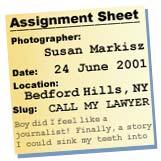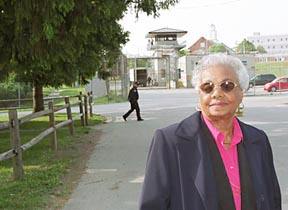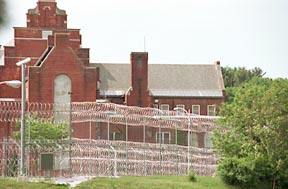
 |
|
Call my Lawyer
by Susan Markisz
May 2001
Bedford Hills, NY
Boy did I feel like
a journalist! Finally, a story I could sink my teeth into, a story that would
take me behind bars, and almost land me in handcuffs several weeks later. Take
it from me, the truth didn't stand a chance while I was on prison property.
The paper had requested permission to interview and photograph inmates months
earlier for a story about higher education at Bedford Correctional Facility,
the only maximum security facility for women in the State of New York, where
some inmates are studying for their Bachelor of Arts and Masters Degrees. Four
days before the assignment date, I submitted my social security number and declared
in writing, every item I would bring into the prison, no cell phones or pagers
allowed.
 |
|
The entrance to Bedford Hills Correctional Facility,
the only
maximum security prison for women in New York State. (c) 2001 Susan B. Markisz for The New York Times |
By way of personal background, although I was a child of the sixties, I had a conservative upbringing, which is to say I was not a member of any revolutionary group and I never had any warrants out for my arrest. I am loathe to admit it but I rarely quibbled with authority. I was outspoken on various topics but politics generally was not one of them. I didn't share my parents' every view of the world, and there are some things in my past I'd rather keep in my past, but my biggest insubordination at the time, was my known affiliation with Communist dissidents when I lived in Franco's Spain. It was not a small matter in those days; several friends had been arrested for their political activities. Frankly, I was more interested in having tapas and sherry with them in the nearest bar and talking about how we were going to change the world than actually doing anything concrete about it. I pretty much considered myself apolitical, having never experienced the kind of political oppression that my friends had. The honest to God truth is that during the years I lived under the Spanish dictatorship, I had never felt safer. My mom and I had experienced a terrifying attack when I was 14, while walking home one evening in my suburban hometown in the States and the man was never caught). So at age 21, when I would walk back to my apartment after a night on the town in Seville, I did not mind the presence of the Guardia Civil on the other side of the street, whom I more or less regarded as my own personal bodyguards. I basically conceded that when it came to authority figures, they must be right.
The first thing I discovered in prison is that when the authority figures are right, they are right, and even when the authority figures are wrong, they are still right.
|
|
During my first
visit to Bedford Correctional Facility, things went relatively smoothly
for awhile. While writer Robert Worth interviewed Superintendent Elaine
Lord in her office, I snapped pictures. She stressed the importance of
higher education in the prison, and the relationship it bears to the future
education and success of the inmates' children. "After all," she said,
"children want to be like their mothers." Better to be studying in prison,
than not, she had said. Education reduces recidivism and as the inmate
mothers set a good example, the better the chances are that their children
will continue their own education. She told us about the nursery, where
we would see inmates living with their babies; some of whom had been born
there
|
| Superintendent Lord seemed like a jolly sort. I got pictures that illuminated her personality. They were not what I wanted though. But after hearing what she had to say during the interview, I figured my way would be paved with golden photographic opportunities. I couldn't have been more wrong. The minute we stepped outside her office, the prison guards ushered me into a room where they locked up my cameras, because, they said, I would not need them for the tour of the prison. I explained I had permission. They said no. I said there's been some mistake, talk to the Superintendent. They told me she was the permission bearer and I would not need my cameras. Period. I wondered what had happened to our deal. |
|
The first place we were taken, of course, was the nursery, where pictures manifested themselves a hundred-fold, where dozens of inmates cared for their infants, fed them, talked to them, read to them. The inmates lived in small cells with cribs next to their cots. Their dull rooms were littered with brightly colored baby paraphernalia---and babies. It was the end of the prison workday and occasional coos and cries could be heard up and down the halls. One inmate nursed her infant in her tiny cell, as another inmate across the hall read a book as her baby slept nearby. The doors to their cells were open!
I mentioned to our escort that it was strange that the warden would have stressed the importance of education and children...and here was a good example of where education begins...and I couldn't shoot it. "Albany didn't approve," she said.
The next place we went was one of
the honor blocks, where some inmates had their own rooms, with colorful curtains
and quilts. Next we went into what looked to me more like a dormitory, with
75 or so inmates in a large room, some on bunk-beds, and others in little office-like
cubicles that were partitioned by means of a chest high 3 inch thick wall separating
them from the others. This looked more like a college dormitory than prison,
yet I was unnerved to be walking around a room with nothing between me and the
maximum security inmates, where I imagined nothing could stop one of them from,
say, grabbing me and holding me hostage. We were given the royal tour and the
only person who could record it was the writer, armed with pen and paper.
 At Bedford Correctional Facility, Janis Garvey, a professor of critical thinking, second from left, leads a class in a disussion about the upcoming execution of Timothy McVeigh. (c) 2001 Susan B. Markisz |
Later on, just before evening classes
were to begin, we returned to the room where my cameras were incarcerated. We
were not allowed to be in the hallways during inmate movement so we waited in
a small room, closely watched by a guard, as the inmates filed into the classrooms.
Finally, we were taken to a classroom resembling an ordinary schoolroom, where
I was able to take pictures of inmates during class for about 15 minutes. There
were no bars here. Oddly enough the subject at hand was the death penalty.
|
|
|
We then interviewed three women studying for their Masters Degrees, all of whom were serving time, over 15 years in each case, for manslaughter. One inmate had been up for parole and denied three times. None of the women wanted to share the circumstances of their convictions. They were bright, intelligent women who seemed to be model prisoners, remorseful of their criminal pasts, looking forward to a future one day on the outside. I didn't feel threatened by them. The only people, who in fact, seemed threatening, were the guards, who seemed more interested in preventing me from illustrating what I perceived to be a very positive story, than foiling any kind of potential escape plan.
I still had not made a visual connection
between prison and education. Inmates at Bedford are required to wear standard
issue prison green prison skirts or pants, but not blouses, which can be any
color but striped. So much for the Alcatraz look .
|
|
Around 8 pm we went down to the Learning Center, a room resembling a library, where I thought I would get a picture of an inmate working on a paper on one of the 30 or so computers (none of which has internet access.) Nope. Albany doesn't want the word out that at Bedford, you can not only get rehabilitation through education, but you can also use a computer too. |
Picture wise, the stuff I'd gotten
was pretty lame compared to the potential the story had. We were escorted out
just before 9pm; after five hours I had no documentary evidence that I had even
been in a prison.
| The second part to this assignment was a no-brainer, but this is where it got dicey. Two weeks later early one morning, I had to go back to photograph Thea Jackson, President Emeritus of the Center for Redirection Through Education, the person who founded the program at the prison. Since Albany had refused us permission to shoot the graduation ceremony itself, I simply had to get a photograph of Mrs. Jackson, who would be attending the ceremony at 9am that day. I dutifully complied with the prison guard's directive not to photograph her on prison property. With the guard watching my every move, I photographed her from a precarious position on a dangerous curve in the street leading down to the prison entrance, knowing that the assignment could be at risk if I set foot inside the prison grounds. I shot a roll of film in various locations from the public road, and called it a day (15 minutes actually). |  Thea Jackson, founder of the Center for Redirection through Education at Bedford Hills Correctional Facility, in front of the prison. (c) 2001 Susan B. Markisz |
Mrs. Jackson said that the graduations were always very emotional and that maybe they would change their mind and let me in. I was doubtful, but I figured I wouldn't be much of a journalist if I didn't at least try.
Something told me to rewind my film and put it in my pocket. I had 2 cameras, one with film loaded at frame 1, the other empty. I announced my intentions to the guard at the gate who said, sure to go right inside and ask the sergeant at the desk. For a half hour, as my cameras sat idly on the sergeant's desk, the ladies from Bedford in their natty attire who volunteer at the prison, arrived to be witnesses to the inmates' redirection through education as I patiently waited the final word on whether I would be allowed to photograph the culmination of the redirection through education. The guards seemed so accommodating that I was beginning to get a little smug: Wouldn't it be cool, I thought, if I came back to the newsroom with pictures from the graduation! Who knows, they might even hire me for my prowess in getting the story! But thirty minutes later, a belligerent sergeant appeared and told me he was confiscating my cameras and film.
Stunned and disbelieving, I refused. Again, he demanded my film saying that the guard outside the gate had reported I had photographed him from inside the prison grounds, which was untrue. The sergeant repeated his order for me to rewind my film and give it to him, as he reached over to forcibly take it from me. A shiver went down my spine. The guard outside had lied and there was nothing I could do. Suddenly Superintendent Elaine Lord materialized out of nowhere to greet the Bedford volunteers. I thought of appealing to her better nature, saying "Hey, don't you remember me, that nice photographer who was here a couple weeks ago, on her best behavior, following the rules and complying with your every demand for non-pictures???" But I realized it was no accident she was here. She knew full well what was happening; she was putting me on notice. I was on prison grounds and this was no democracy. My next thought was to call my editor at the Times. But I realized that I had a choice: I could battle it out on principle and get arrested, or if I were smart, I might be able to leave with my roll of film. I decided to cut my losses and fight the battle after I left the premises.
I rewound my unexposed roll of film into my camera, opened up the back and gave the guard the film, mumbling something about how my editor was going to be really pissed off. When he pointed to my second camera, which had no phantom film to rewind, I opened the back and explained I had not loaded the camera with film. Sensing there must be an errant roll of film somewhere, he demanded that I dump out the contents of my camera bag, including lenses, flash, and 15 rolls of unexposed film. He directed me to return the contents to my bag and then he escorted me to my car, indicating that Albany would process the roll of film and make a determination about whether I could get it back. "Gotcha," I thought as I walked out the door with my exposed roll of film of Mrs. Jackson safely in my pocket.
I still needed pictures of the prison
grounds from the street. Since they were still harassing me, I didn't want to
jeopardize the film I had. I called my editor who called the lawyers at the
Times to let them know what was going on.
 Bedford Hills Correctional Facility, the only maximum security prison for women in the State of New York. (c) 2001 Susan B. Markisz for The New York Times |
A short time later, armed with the lawyer's phone number, I ambled past the same guard who had reported me to the superintendent of the prison, as I took pictures of the prison from the street. He threatened me with arrest, saying I was on prison property. He was on his radio as I picked up my cell phone. There were three little words I was just itching to use: "Call my lawyer..." Instead, I politely reminded him that I was on a public road and as I picked up my camera, he told me sarcastically to be careful not to get myself killed while shooting from the road.
I learned a couple of things from this non-photo opportunity. Prison is like a paramilitary organization. There are no rights there, for prisoners or for visitors. And this much is true: I do not think I will be allowed back there any time soon, unless it's with a criminal record. They've got my number. Believe me, I now have a much different perspective of truth, prison, and the American way.
Susan B. Markisz